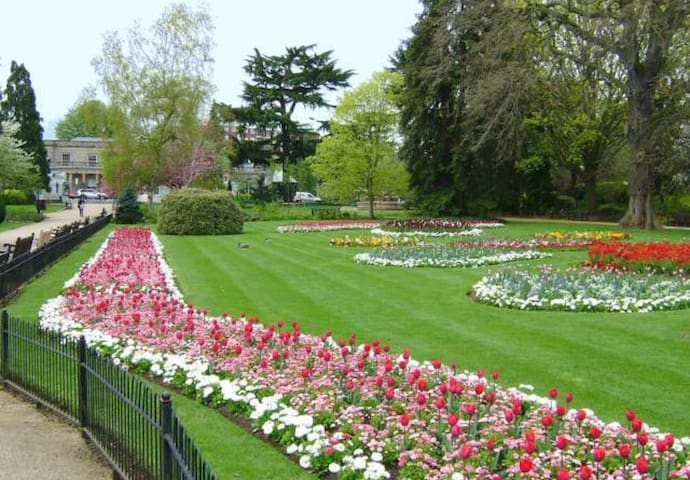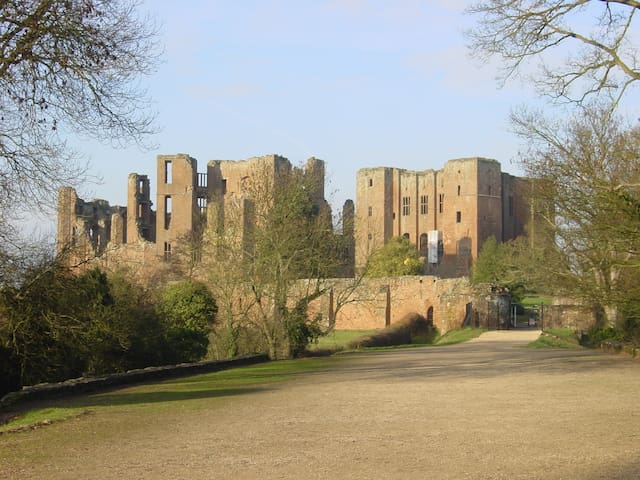Sightseeing
The Jephson Gardens are formal gardens, together with a grassed park, in the town of Leamington Spa, Warwickshire. The gardens, once a place for the wealthy to 'take the air' and 'be seen', are found in the centre of the town on the Parade, with the River Leam flowing to the south of them. One of the town's most popular tourist attractions, they have facilities such as cafes and floral displays. The gardens are often marketed in tandem with the nearby all-grassed Mill Gardens on the south side of the river. The gardens have a total area of 14.6 acres (59,000 m2) with Mill Gardens and its boating lake, both on the opposite side of the river, providing an extra 3.9 acres (16,000 m2).
61 Recomendado por los habitantes de la zona
Jardines Jephson
Newbold TerraceThe Jephson Gardens are formal gardens, together with a grassed park, in the town of Leamington Spa, Warwickshire. The gardens, once a place for the wealthy to 'take the air' and 'be seen', are found in the centre of the town on the Parade, with the River Leam flowing to the south of them. One of the town's most popular tourist attractions, they have facilities such as cafes and floral displays. The gardens are often marketed in tandem with the nearby all-grassed Mill Gardens on the south side of the river. The gardens have a total area of 14.6 acres (59,000 m2) with Mill Gardens and its boating lake, both on the opposite side of the river, providing an extra 3.9 acres (16,000 m2).
Warwick Castle is a medieval castle developed from a wooden fort, originally built by William the Conqueror during 1068. Warwick is the county town of Warwickshire, England, situated on a bend of the River Avon. The original wooden motte-and-bailey castle was rebuilt in stone during the 12th century. During the Hundred Years War, the facade opposite the town was refortified, resulting in one of the most recognisable examples of 14th-century military architecture. It was used as a stronghold until the early 17th century, when it was granted to Sir Fulke Greville by James I in 1604. Greville converted it to a country house and it was owned by the Greville family, who became Earls of Warwick in 1759, until 1978 when it was bought by the Tussauds Group.
https://en.wikipedia.org/wiki/Warwick_Castle
270 Recomendado por los habitantes de la zona
Warwick Castle
Warwick Castle is a medieval castle developed from a wooden fort, originally built by William the Conqueror during 1068. Warwick is the county town of Warwickshire, England, situated on a bend of the River Avon. The original wooden motte-and-bailey castle was rebuilt in stone during the 12th century. During the Hundred Years War, the facade opposite the town was refortified, resulting in one of the most recognisable examples of 14th-century military architecture. It was used as a stronghold until the early 17th century, when it was granted to Sir Fulke Greville by James I in 1604. Greville converted it to a country house and it was owned by the Greville family, who became Earls of Warwick in 1759, until 1978 when it was bought by the Tussauds Group.
https://en.wikipedia.org/wiki/Warwick_Castle
Stratford-upon-Avon is a market town and civil parish in the Stratford-on-Avon District, in the county of Warwickshire, England, on the River Avon, 8 miles (13 km) south west of Warwick/Leamington Spa.
Stratford was originally inhabited by Anglo-Saxons and remained a village before the lord of the manor, John of Coutances, set out plans to develop it into a town in 1196. In that same year, Stratford was granted a charter from King Richard I to hold a weekly market in the town, giving it its status as a market town. As a result, Stratford experienced an increase in trade and commerce as well as urban expansion.
The town is a popular tourist destination owing to its status as the birthplace and gravesite of playwright and poet William Shakespeare, and receives approximately 2.5 million visitors a year. The Royal Shakespeare Company resides in Stratford's Royal Shakespeare Theatre.
https://en.wikipedia.org/wiki/Stratford-upon-Avon
533 Recomendado por los habitantes de la zona
Stratford-upon-Avon
Stratford-upon-Avon is a market town and civil parish in the Stratford-on-Avon District, in the county of Warwickshire, England, on the River Avon, 8 miles (13 km) south west of Warwick/Leamington Spa.
Stratford was originally inhabited by Anglo-Saxons and remained a village before the lord of the manor, John of Coutances, set out plans to develop it into a town in 1196. In that same year, Stratford was granted a charter from King Richard I to hold a weekly market in the town, giving it its status as a market town. As a result, Stratford experienced an increase in trade and commerce as well as urban expansion.
The town is a popular tourist destination owing to its status as the birthplace and gravesite of playwright and poet William Shakespeare, and receives approximately 2.5 million visitors a year. The Royal Shakespeare Company resides in Stratford's Royal Shakespeare Theatre.
https://en.wikipedia.org/wiki/Stratford-upon-Avon
Kenilworth Castle is located in the town of Kenilworth in Warwickshire, England. Constructed from Norman through to Tudor times, the castle has been described by the architectural historian Anthony Emery as "the finest surviving example of a semi-royal palace of the later middle ages, significant for its scale, form and quality of workmanship".[1] Kenilworth has also played an important historical role. The castle was the subject of the six-month-long Siege of Kenilworth in 1266, thought to be the longest siege in Medieval English history, and formed a base for Lancastrian operations in the Wars of the Roses. Kenilworth was also the scene of the removal of Edward II from the English throne, the French insult to Henry V in 1414 (said by John Strecche to have encouraged the Agincourt campaign), and the Earl of Leicester's lavish reception of Elizabeth I in 1575.
96 Recomendado por los habitantes de la zona
Kenilworth Castle and Elizabethan Garden
Castle RoadKenilworth Castle is located in the town of Kenilworth in Warwickshire, England. Constructed from Norman through to Tudor times, the castle has been described by the architectural historian Anthony Emery as "the finest surviving example of a semi-royal palace of the later middle ages, significant for its scale, form and quality of workmanship".[1] Kenilworth has also played an important historical role. The castle was the subject of the six-month-long Siege of Kenilworth in 1266, thought to be the longest siege in Medieval English history, and formed a base for Lancastrian operations in the Wars of the Roses. Kenilworth was also the scene of the removal of Edward II from the English throne, the French insult to Henry V in 1414 (said by John Strecche to have encouraged the Agincourt campaign), and the Earl of Leicester's lavish reception of Elizabeth I in 1575.



